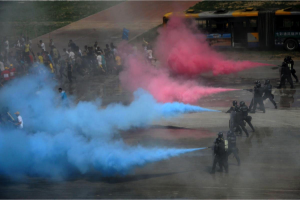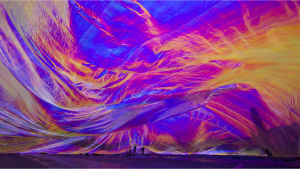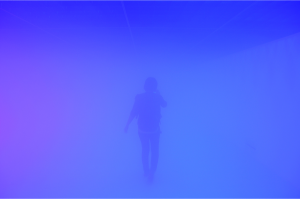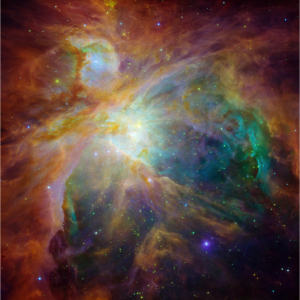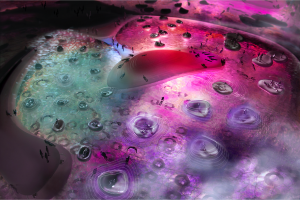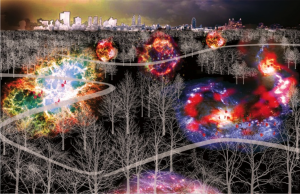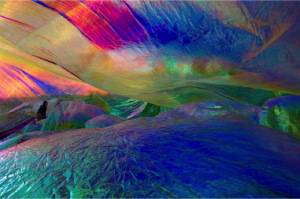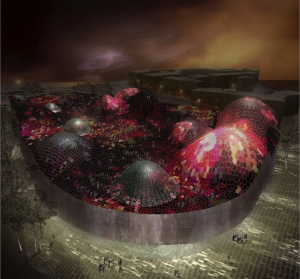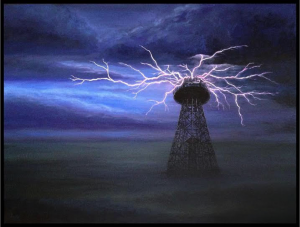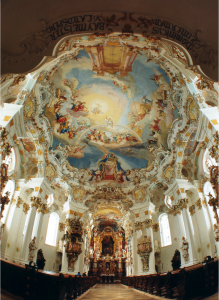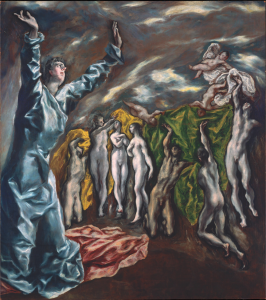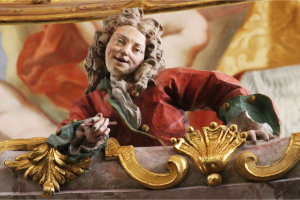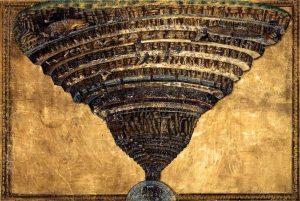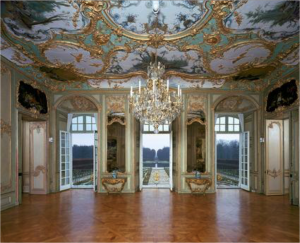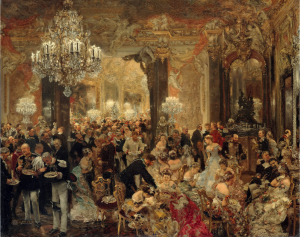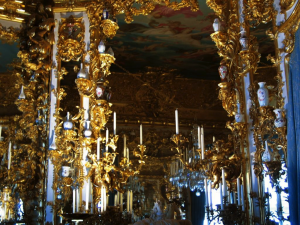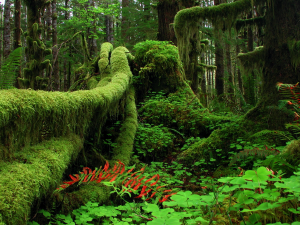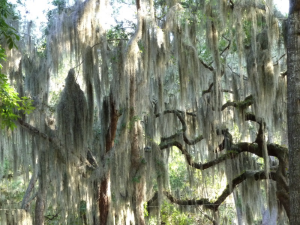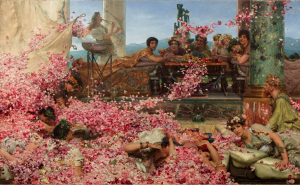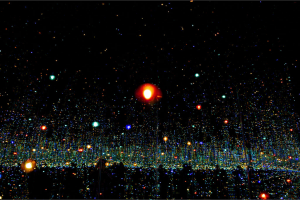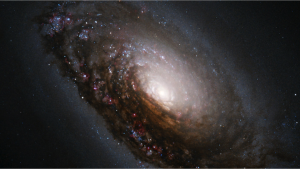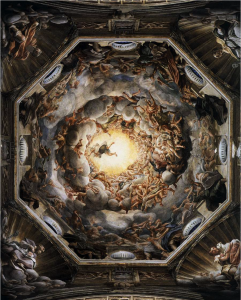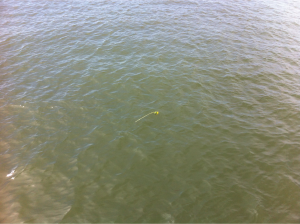A utopia of the crowds, a city designed for sensory overload, emotional extremes, and deindividuation where the romantic notion of psychological interiority is everted and becomes a romance of the surface. Ochlotopia is a series of enclosures: infinite interiors nested one within the other. Through blasts of color and sensation, the gleeful gaudiness and excess of rococo interior, rivers of blood and tears, the crowd enters into a synaesthetic space, a sensuous cavity-cum-skin, and becomes a collective nervous system. (Cedric Williams, William Scarlett)
The stage will no longer be a colored backdrop but a colorless electromechanical architecture, powerfully vitalized by chromatic emanations from a luminous source. … From these will arise vacant abandonments, exultant, luminous corporealities … Instead of the illuminated stage, let’s create the illuminating stage: luminous expression that will irradiate the colors demanded by the theatrical action with all its emotional power… Vibrations, luminous forms (produced by electric currents and colored gases) will wriggle and writhe dynamically, and these authentic actor-gases of an unknown theatre will have to replace living actors
The currents of color that swept around us – we were told that these used to be humans, like us. They were so devoted to the color worlds they envisioned that they traveled backwards on light rays out of their own eyes, turning completely inside out and becoming light incarnate.
The dance of colored gas, like an industrial accident gone right, poisons us with a free and surging wave of love, drowning us in one another’s depths.
To dissolve into pure sensation as if into a mirage, into an all-consuming dream of color.
The streets of Ochlotopia are filled with colored gases. We dance in and out of the polychromatic mists, we breathe them in and out body-parts emerge from them. The Ochlotopian self evaporates and hisses-out into the cosmos under the sign of full moons, tracer bullets, fireworks, polluted heavens, colored lights intermingling, projected against one another from various angles, reflecting and refracting off variably reflective and shifting surfaces, bouncing between a sheet of fresh snow and a blanket of clouds, sliding across a bus’s windows, skipping along the river’s chop. Motley lights in the iridescent mist incessantly merging, dividing, spewing forth, switching on and off.
When we asked who built Ochlotopia, we were answered only with fluttering, celestial laughter. It seems that nobody actually built Ochlotopia, since its structures materialized from emergent currents of collective affect.
Where there are no structures, such as in the interior garden, nebular architectures emerge around bodies and absorb them. Sometimes they float around like puffy clouds. Other times they collide in dazzling explosions of sparks. Each is a singular embodiment of the particular relations of its inhabitants, and so its nature can change with the slightest breeze. The tendrils of these nebulas writhe about with electric potential, often to the detriment of nearby foliage.
Our hands no longer belong to our bodies. A hand caresses a face. Whose hand? Whose face? In the Ochlotopian street, projection mapping transforms our faces in accordance with the desires that run between and through us. “A trick of the light,” yes, but Ochlotopians give no priority to either surfaces or depths. It is the rapid alternation between illusion and materiality, the camoufleur’s sleight of hand, that produces a certain frequency, a certain power. It said that every profound spirit needs a mask: even more, around every profound spirit a mask is growing continually, owing to the constantly false, namely shallow, interpretation of every word, every step, every sign of life she gives.
The Ochlotopic ocean hovers and gyrates as an effect of its multi-dimensional surface cohesion. Just as in the hollow asteroid colonies, in which a gravitationless space of a few cubic miles is equivalent to entire counties of farmland on Earth, this ocean is the equivalent of the surface of the Atlantic folded within the size of a large stadium. Ochlotopians engage in all manner of aquatic recreation between the water’s folds.
Pulsating with the arrhythmia of a collective heart, this is the source of nourishment in Ochlotopia. Drawing up vital essences from deep underground and combining them with airborne particles, food is distributed evenly to all citizens as it permeates the air they breathe. Although it is tasteless and scentless, Ochlotopians do not feel deprived of gourmet experience, because their senses have become detached from all necessity and are stimulated only for their enjoyment.
In 1905, the famous and eccentric inventor Nikola Tesla dreamed up a tower that could wirelessly power all of civilization. A prototype was built on Long Island, New York at the turn of the century, but this tower is dwarfed by its Ochlotopia successor, which rises out of the colored mists, spraying purple lightning that flashes through the eternally recurring sunrise. “In this system that I have invented,” Tesla wrote, “it is necessary for the machine to get a grip of the earth…otherwise it cannot shake the earth. It has to have a grip… so that the whole of this globe can quiver.” Deep iron roots plunge into the center of the earth and wrap around its molten core, and with their strong hold on the earth’s quivering heart, they use it’s rotation and magnetism to pump-up electricity that flies up out the tower’s pineal eye. Here, electrical power flows through all matter, and can be harvested at will.
Buildings in Ochlotopia are experiments in architectural traveling. Crossing their indeterminate thresholds opens onto interior infinity. Ochlotopia is a city of infinities, with an equal number of transcendences. A frothing and foaming of heavens. Each as a final intensification of theatrical architecture: the real that merges into the painted; the painted that merges into the real. The images are no longer painted, but emitted in plumes of the vaporous substance of imagination.
Ochlotopian raptures under the religiously polluted heavens. Souls rise up through the gaseous sieve and cascade back down into the city, intermingled as an acid rain of collective emotion that baptizes the flesh and attaches it to new bones, to a skeleton-web that enmeshes and encompasses the multitude. Denuded, empty, groping-through the cloud of unknowing…and then the city cloaks us in colored robes and we shed a river of mindless tears, together at last.
What has become of the human in Ochlotopia? Has it been reduced, or has it been exceeded? The Bavarian Rococo church builder Egid Quirin Asam signed his work in a manner comparable to the Northern Renaissance painters, whose initials were inscribed on a stone or board pictured inside the image. His signature was a life-like sculpture of himself within the architectural space. As a total composition that blurred life and object, his creation included himself in objectified form. All of this is to say that, in Ochlotopia, the same diffusion of self that marks its retreat to a lesser state coincides with the perfection of its becoming integrated into a higher being, a nature beyond individual comprehension, and therefore superior to every individuality. At least this is what they told us…
Ochlotopians move from the periphery to the center of their city as we would from the outer to the inner self, from our births towards our deaths, through the inferno and into the starlight of the heavens, or from the light of the false sun into the apophatic darkness. It is a mystic itinerary, but completely spatialized, so that it is reversible, so that it can be wandered and danced.
The topos of Ochlotopia is a climatological architecture. The buildings continuously grow and spill over into their surroundings. One is never sure if it is a building or an atmosphere teeming with life on the other side of each doorway. Nature, as we understand it, doesn’t exist in Ochlotopia, because it has been completely integrated into the structure of the city. This is not to say that it has been domesticated, because it grows wildly and chaotically beyond the limits of every seemingly established form.
Ochlotopian clothing descends from the atmosphere and swirls around the body, or bodies. There is no discernable separation between body, clothing and architecture; only the undulating gestures of the crowd create visible distinction. The swirling movements, like filaments of saliva suspended in water, display the social grace of weather systems. Condensing and bursting forth again in a dance the exquisite choreography of which can only be compared to those 18th century balls that were the most delicately restrained of orgiastic reveries.
Reflections abound within Ochlotopia, teeming with enticements to lure one into imaginary realms, through the looking glass. The confusion of reflection and reality is compounded by the light-based bodies of many Ochlotopians, who can inhabit imaginary spaces with ease. This kind of thing embodies, in a masterly unsound manner, nothing less than the wishful image again to live in a different space from the existing one, in fact in a deliberately impossible space.
Ochlotopia is a walled city. The infinitude of it’s interior depends upon it’s being sealed away from the howling wilderness that presses-in on its boundaries. Indeed, a utopia is not marked by its central tenants or essence, but by the boundaries between itself and an outside world. Like a neuronal cell, whose power is produced along it’s membranous surface, through the amplification of a difference between inside and out, the utopian charge is most electric when freedom of life outside collides with the carapace of an infinite interior.
On the “star forts” of the 18th century: “If the fortified town is an immobile machine, the military engineers specific task is to fight against its inertia. ‘The goal of fortification is not to stop armies, to contain them, but to dominate them and even to facilitate their movements’…’the art of defense must constantly be in transformation; it is not exempt from the general law of this world; stasis is death’…the communal fortress is a city machine, so much so that…many of the engineers of the eighteenth century, in their ‘fictional diaries of sieges’ or their ‘moments of fortification,’ don’t even mention the troops assigned to defend it, as if the fortress were capable of functioning by itself’
Just so, the walls of Ochlotopia are a living scupture carved out of the dialectical interplay between the monadic, poetic individualists of the wilderness beyond and the mechanical solidity of the city’s infinite interior: a population that, though not undifferentiated, is deindividuated, subject to to communal pulses of color, emotion, and sensation. It is a city whose walls, whose surface, whose collective face that looks out onto the forests and oceans of the beyond, is shaped by erosion.
Aging Ochlotopians can often be seen resting on tree-like structures such as this, which suspends them in a more dignified posture and supplies them with the intra-ethereal sustenance that they are no longer able to absorb from the air.
It is said that the 3rd century roman emperor, El Gabal, a Syriac mystic and priest who installed his phallic meteorite as the Sun-king, put his enemies to death by inundating them in rose petals. The Ochlotopians know of this beautiful tale, but have inverted it, so that the poet’s corpse, returned to the city, is inundated by sentient petals that drink his blood. His death becomes a multitude of little, fleeting lives. The petals turn red with anger, blood, shame, blood and love. Some scatter in the wind, the others are devoured during the great funereal feast. Thus the hardened soul is blown back into the collective, like the spirit of a gift.
What is the Infintesimalium? A voyage to subatomic worlds, intended for wayward consciousnesses which abandon the senses to inhabit purer scales. Like the desert hermits of 3rd century Egypt, here the intellect meditates eternally on the tiniest of truths.
Ochlotopia, seen from space.
The same image magnified, a lot.
During the long, Northern winters, sometimes, a great storm rises up out of the immense, green, ferocious ocean and rails against the city walls. And the crags and tunnels that pockmark the uneven, shifting, labyrinthine walls catch the wind in such a way that song howls out, a song sung by the city itself. This is the song the city sings to the poets of the forests beyond, the song of Will and Wave:
Rush through every recess of the seaside crags, run our thousand hands over stones made smooth and spheroid from our long and systematic abuses and, equally, against erect knives of fresh lava rock that do not yet know our relentless attentions. Our waves will immerse the manifold gem just as our hands close around a jewel. We will recede, step back and eye the gem lustily, pierce it with our lightbems…and we’ll be scattered by it, in every direction, like the spiderweb frequency of stars. Then, again, we’re back as the seventh wave, even more violently, hungrily, white and frothing at the crests with excitement. We’ll strip your shores; property is theft and anything is permitted so long as it wells-up from the depths, breaches the mirror surface, and strains up and and against the false sun. See, already, another wave is already drawing near, again another wave is approaching, coming close, again, wave is nearing, still more greedily and wildly until the seventh; and its soul is full of secrets too and its soul has a treasure map made of skin, and its soul wants to dig through your flesh for pleasure-treasure. The pyramidal wave that pulls the veil of blinding light off of the sun stands before you, a waterlogged corpse endlessly falling from this pinnacle down into and through the deep ocean’s trenches…only when we have achieved this height will I dive again, pour my emeralds into the depths, pry open the asphalt ribcage so that the cobblestone beach below pours out like a broken hourglass. And when your body has been fully broken down into relics and the greedy ocean currents have carried these away so that they are borne by wave after wave on distant shores like a talismans into battle or saints through terror and hardship, only then will our love will spray forth like octopus eggs into the chaos-night…this is a religious love drowned in secret, a death flown through and pulled apart.
It is now night, and nothing is visible. But even before, with his eyes half-closed against the relentless sun, with dark red blotches appearing beneath his eyelids, the deep blue of sea and sky had seemed black. After all, the universe itself is dark, and only the eye, like some pedantic philologist, is obsessed with the translation of invisible wavelengths into light and colour. Nothing is really visible, not even in the noon sun’s blinding reflection on the shimmering sea. A magical time, when gods appear.
